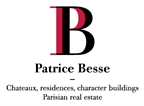A grand 18th-century house with an outbuilding and garden, nestled 25 minutes from the town of Vendôme, in France's Centre Val de Loire region - ref 2
A grand 18th-century house with an outbuilding and garden, nestled 25 minutes from the town of Vendôme, in France's Centre Val de Loire region.
The property lies in the west of France's Loire-et-Cher department, in the north-west corner of the Centre Val de Loire region. It is tucked away in a quaint village that is located 10 minutes from the charming town of Saint-Calais. The village is 25 minutes from the town of Vendôme and its high-speed train station, from where you can get into central Paris in just 40 minutes by rail. It is nestled in beautiful, undulating countryside through which rivers gently flow.
The house has a courtyard and a garden on an enclosed plot that covers around 5,000m². From a village road on one side of the property, a metal gate leads onto a path that takes you to the main court and the outbuilding, which stands in the grassy, tree-dotted garden. In front of the house, there is a second court with vegetation. It faces one of the village's squares. The main court faces north and south and the pavilion, at a right angle to the house's main section, looks westwards. The stone elevations are coated with rendering. All the home's windows are set in surrounds of red brickwork. The hipped roofs are covered with slate tiles, except for one of the outbuilding's roof slopes, which is covered with flat tiles. The imposing dwelling has kept the attributes that make it typical of classic upper-middle-class houses of its time. Its reception rooms are adorned with mouldings, fireplaces and chevron parquet.
The houseThe house has a main section with a pavilion at a right angle to it. Both have a ground floor, a first floor and a roof space, though the pavilion's roof space is lower and cannot be converted. The rendered elevations are punctuated with small-paned windows set in slightly arched surrounds. The entrance door is glazed and off-centre. Gabled dormers with triangular pediments stand upon the main section's roof. The architectural articulation is plain, centred on the surrounds of red brickwork.
The ground floor
The entrance hall is a dual-aspect space. It connects to a lavatory. From this hallway, a staircase leads upstairs. The hall's floor tiles are laid in a brown-and-white checked pattern and its walls are adorned with dado panelling. On one side, the hall connects to a lounge with chevron parquet, dado panelling, a ceiling with mouldings and a ceiling rose, and a fireplace with a finely sculpted wooden mantel and a cast-iron firebox embellished with fleurs-de-lys, beneath a chimney breast of finely sculpted wooden panelling with a mirror and a painting. On the other side, the hall connects to a dining room with similar decor. The room leads into a pantry on one side. This pantry leads out into the court in front of the house. On the other side, the room leads to a hallway. This hallway has a door that takes you out into the main court and it then leads to the kitchen, which has a floor of tiles laid in a checked pattern. On the ground floor of the pavilion that stands at a right angle to the main section, two rooms form a self-contained unit that is separate from the rest of the house. You reach this self-contained unit from the courtyard. A door leads to a kitchen with a tiled floor, a shower room and a lounge with wood strip flooring, where a staircase leads up to the first floor.
The first floor
A spacious landing connects to all the rooms of the main section. A wrought-iron balustrade with a wooden handrail edges this space. There is a first bedroom, then a second bedroom, which shares a shower room with a third bedroom. The walls of the three bedrooms are painted. At one end of the landing, a hallway connects to a lavatory, a bathroom and a walk-in wardrobe. At the other end, a door leads to a flight of stairs that takes you up to the loft. Wood ...


